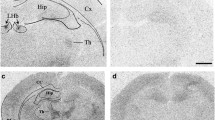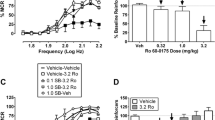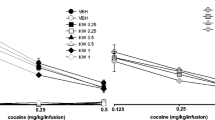Summary
5-HT3 receptors are abundant in central dopamine (DA) terminal areas. They do not affect basal DA turnover but appear to modulate DA release by e.g. morphine and nicotine. The interpretation of these findings is uncertain, and it is unclear whether 5-HT3 receptors also influence the activity of compounds such as amphetamine and cocaine, which act more directly on the DA synapse. Variable-interval (VI), threshold-current hypothalamic self-stimulation can provide a continuous index of central dopaminergic activity, but is relatively insensitive to changes in 5-HT and thus offers a means of investigating this question. In the present study, a selective 5-HT3 receptor antagonist, ondansetron (GR 38032F) (1.0 to 1000 μg/kg sc), had no effect on VI self-stimulation, nor did a 100 μg/kg dose affect facilitation of responding byd-amphetamine (500 jig/kg ip). Ondansetron (100 μg/kg) reduced the initial depression of self-stimulation by high-dose nicotine (400 μg/kg), but not the ensuing facilitation. Similar results were obtained in rats “sensitized” to nicotine by prior chronic exposure. These results support the proposal that 5-HT3 receptors, normally quiescent under basal conditions, mediate the excitatory effect of compounds acting upstream from the DA neuron, such as nicotine, but do not affect the dopaminergic synapse directly.
Similar content being viewed by others
References
Acquas E, Carboni E, Garau L, Di Chiara G (1990) Blockade of acquisition of drug-conditioned place aversion by 5-HT3 antagonists. Psychopharmacology 100: 459–463
Bialajew C, Shizgal P (1986) Evidence implicating descending fibres in self-stimulation of the medial forebrain bundle. J Neurosci 6: 919–929
Blandina P, Goldfarb J, Craddock-Royal B, Green JP (1989) Release of endogenous dopamine by stimulation of 5-hydroxytryptamine3 receptors in rat striatum. J Pharmacol Exp Ther 251: 803–809
Butler A, Hill JM, Ireland SJ, Jordan CC, Tyers MB (1988) Pharmacological properties of GR 38032F, a novel antagonist at 5-HT3 receptors. Br J Pharmacol 94: 397–412
Carboni E, Acquas E, Frau R, Di Chiara G (1989a) Differential effects of 5-HT3 antagonists on drug-induced stimulation of dopamine release. Eur J Pharmacol 164: 515–519
Carboni E, Acquas E, Leone P, Di Chiara G (1989b) 5-HT3 receptor antagonists block morphine- and nicotine- but not amphetamine-induced reward. Psychopharmacology 97: 175–178
Chen J, Van Praag HM, Gardner EL (1991) Activation of 5-HT3 receptor by 1-phenyl-biguanide increases dopamine release in the rat nucleus accumbens. Brain Res 543: 354–357
Clarke PBS (1990) Mesolimbic dopamine activation — the key of nicotine reinforcement? In: Bock G, Marsh J (eds) The biology of nicotine dependence. Ciba Symposium 152. Wiley Chichester
Clarke PBS, Kumar R (1983) The effects of nicotine in non-tolerant and tolerant rats. Br J Pharmacol 78: 329–3374
Costall B, Domeney AM, Naylor RJ (1982) Behavioural and biochemical consequences of persistent overstimulation of mesolimbic dopamine systems in the rat. Neuropharmacology 21: 327–335
Costall B, Domeney AM, Naylor RJ (1983) A comparison of the behavioural consequences of chronic stimulation of dopamine receptors in the nucleus accumbens of rat brain effected by a continuous infusion or by single daily injections. Naunyn Schmiedebergs Arch Pharmacol 324: 27–33
Costall B, Domeney AM, Naylor RJ, Tyers NB (1987) Effects of the 5-HT3 receptor antagonist, GR38032F, on raised dopaminergic activity in the mesolimbic system of the rat and marmoset brain. Br J Pharmacol 92: 881–894
Costall B, Naylor RJ, Tyers MB (1988) Recent advances in the neuropharmacology of 5-HT3 agonists and antagonists. Rev Neurosci 2: 41–65
Domeney AM, Costall B, Gerrard PA, Jones DNC, Naylor TJ, Tyers MB (1992) The effect of ondansetron on cognitive performance in the marmoset. Pharmacol Biochem Behav 38: 169–175
Hagan RM, Jones BJ, Jordan CC, Tyers MB (1990) Effect of 5-HT3 receptor antagonists on responses to selective activation of mesolimbic dopaminergic pathways in the rat. Br J Pharmacol 99: 227–232
Herberg LJ, Rose IC (1990) Excitatory amino acid pathways in brain-stimulation reward. Behav Brain Res 39: 230–239
Herberg LJ, Stephens DN, Franklin KBJ (1976) Catecholamines and self-stimulation: evidence suggesting a reinforcing role for noradrenaline and a motivating role for dopamine. Pharmacol Biochem Behav 4: 575–582
Herberg LJ, de Belleroche JS, Rose IC, Montgomery AMJ (1992) Effect of the 5-HT3 receptor antagonist ondansetron on hypothalamic self-stimulation in rats and its interaction with the CCK-analogue caerulein. Neurosci Lett 140: 16–18
Higgins GA, Joharchi N, Nguyen P, Sellers EM (1992) Effect of the 5-HT3 receptor antagonists, MDL 72222 and ondansetron on morphine place conditioning. Psychopharmacology 106: 315–320
Jiang LH, Ashby CR Jr, Kasser RJ, Wang RY (1990) The effect of intraventricular administration of the 5-HT3 receptor agonist 2-methylserotonin on the release of dopamine in the nucleus accumbens: an in vivo chronocoulometric study. Brain Res 513: 156–160
Jones BJ, Costall B, Domeney AM, Kelly ME, Naylor RJ, Oakley NR, Tyers MB (1988) The potental anxiolytic activity of GR 38032F, a 5-HT3 receptor antagonist. Br J Pharmacol 93: 985–993
Kilpatrick GJ, Jones BJ, Tyers MB (1987) Identification and distribution of 5-HT3 receptors in rat brain using radioligand binding. Nature 330: 746–748
Kilpatrick GJ, Bunce KT, Tyers MB (1990) 5-HT3 receptors. Med Res Rev 10: 441–475
Marty M, Pouillart P, Scholl S, Droz JP, Azab M, Brion N, Pujade-Lauraine E, Paule B, Paes D, Bons J (1990) Comparison of the 5-hydroxytryptamine3 (serotonin) antagonist ondansetron (GR 38032F) with high-dose metoclopramide in the control of cisplatin-induced emesis. N Engl J Med 322: 816–821
Moore KE, Chiueh CC, Zeldes G (1977) Release of neurotransmitters from the brain in vivo by amphetamine, methylphenidate and cocaine. In: Ellinwood EH, Kilbey MM (eds) Cocaine and other stimulants. Plenum Press, New York, pp 143–160
O'Neill MF, Dourish CT, Iversen SD (1991) Evidence for an involvement of D 1 and D 2 dopamine receptors in mediating nicotine-induced hyperactivity in rats. Psychopharmacology 104: 343–350
Paris JM, Cunningham KA (1991) Serotonin 5-HT3 antagonists do not alter the discriminative stimulus properties of cocaine. Psychopharmacology 104: 475–478
Pellegrino LJ, Pellegrino AS, Cushman AJ (1979) A stereotaxic atlas of the rat brain. Plenum Press, New York
Peltier R, Schenk S (1991) GR 38032F, a serotonin 5-HT3 antagonist, fails to alter cocaine self-administration in rats. Pharmacol Biochem Behav 39: 133–136
Rose IC, Mintz M, Herberg LJ (1988) Chronic l-dopa fails to lessen rebound enhancement of self-stimulation after chronic haloperidol. Pharmacol Biochem Behav 30: 585–588
Schaefer GJ, Michael RP (1992) Schedule-controlled brain stimulation: has it utility for behavioural pharmacology? Neurosci Biobehav Rev (in press)
van der Hoek GA, Cooper SJ (1990a) Antagonism of amphetamine-induced sniffing, but not hyperlocomotion, by the selective 5-HT3 antagonist, ondansetron. Br J Pharmacol 100: 414P
van der Hoek GA, Cooper SJ (1990b) Evidence that ondansetron, a selective 5-HT3 antagonist, reduces cocaine's psychomotor stimulant effects in the rat. Psychopharmacology 101: S 59 (Abstr)
Wettstein JG, Junien J-L (1992) Effect of 5-HT3 antagonists on fixed-interval behaviour in rats. Pharmacol Biochem Behav 41: 659–662
White A, Corn TH, Feetham C, Faulconbridge C (1991) Ondansetron in the treatment of schizophrenia. Lancet 337: 1173
Wise RA (1978) Catecholamine theories of reward: a critical review. Brain Res 152: 215–247
Wozniak KM, Pert A, Linnoila M (1990) Antagonism of 5-HT3 receptors attenuates the effects of ethanol on extracellular dopamine. Eur J Pharmacol 187: 287–289
Author information
Authors and Affiliations
Rights and permissions
About this article
Cite this article
Montgomery, A.M.J., Rose, I.C. & Herberg, L.J. The effect of a 5-HT3 receptor antagonist, ondansetron, on brain stimulation reward, and its interaction with direct and indirect stimulants of central dopaminergic transmission. J. Neural Transmission 91, 1–11 (1993). https://doi.org/10.1007/BF01244914
Received:
Accepted:
Issue Date:
DOI: https://doi.org/10.1007/BF01244914




